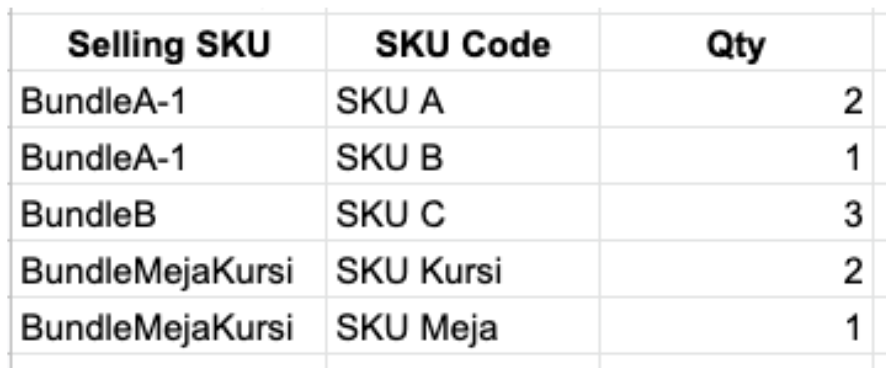Virtual Bundling
Updated by 29 Aug 2023
Introduction
Virtual Bundling is a feature from Shipper OMS which will replace the hard bundle process that we have now. This is the example of the template for Virtual Bundling.

Note: Based on this template, the client wants to make:
- BundleA-1 with composition of SKU A of 2 qty and SKU B of 1 qty.
- Bundle B with composition of SKU C of 3 qty
- BundleMejaKursi with composition of SKU Kursi of 2 qty and SKU Meja of 1 qty
So when order comes of selling SKU BundleA-1 it will immediately translates to SKU A 2 pcs and SKU B 1 pcs.
You can create the bundle sku with Create Bundle SKU endpoint and after that you have to activate the bundle with PUT Active/Inactive on Bundle SKU endpoint. To get the list of Bundle SKU that you have created you can use GET Bundle SKU endpoint.
Assigned/Release Stock
Currently if you're not using this endpoint we will only give you the qty of each SKU individually. This will be a hassle since you have to calculate how many stocks you have to show in your system.
If you like it you can use the Assigned Stock feature which the system will lock the stock of each individual SKU, reserve it specially for bundle and it will deduct the qty of individual SKU. note: this stock will not be stagnant, so the assigned stock will decrease once there's an order comes along.
You can also choose to Release the lock stock if you feel like you wanted to sell the individual SKU as your priority. After you release the stock with the number that you desire, the stocks will be back to the individual SKU based on that number.
Example of Assigned Stock

Note: For example this client set the BundleAB which consist of: SKU A 1qty and SKUB 1qty. They would like to assigned 30 qty as the stock for BundleAB. So the new qty of each individual qty will be:
- SKU A: [50-30 = 20qty] 20 Qty will be shown when you get stock of SKU A
- SKU B : [60-30 = 30qty] 30 Qty will be shown when you get stock of SKU B
You can create the assigned stock with Create Assign Stock endpoint, release it with Create Release Stock endpoint. You can also get the stock with GET Assigned Stock endpoint or using GET Inventory Stock endpoint.
Restock Configuration
Because the assigned stock will decrease along with the orders comes with the bundle, it will be a hassle for you if you have to Assigned the stock every time the stock is empty. So we have a feature to support automatic restock for your Bundle SKU.
We have several component to this Restock configuration:
- Target Restock qty: How much restock qty do you want
- Min Stock Qty: Minimum of the qty which triggered automatic restock
- Auto Restock: If the stock in Shipper's warehouse below of your target qty would you like to restock it altogether or you prefer to not restock
This is the example:

Note: For this client they already set 2 bundles; BUNDLEAB and BUNDLEAC. They would like to restock with rules as follows:
- BUNDLEAB to be restocked to 15qty, so when it reaches the 5 bundle qty, it will automatically resets to 15. And if it turns out the individual SKU is not enough to be restocked to 15, they preferred to restock it to the most that the individual SKU can do.
- BUNDLEAC to be restocked to 10qty, so when it reaches the 2 bundle qty, it will automatically resets to 10. And if it turns out the individual SKU is not enough to be restocked to 10, they preferred to not restock it.
You can create this configuration with Create Restock Configuration endpoint
Release Stock
If there is any reason client wants to release stock due to preferring to sell the individual SKU you can release the assigned stock using Create Release Stock endpoint
Integration Flow

Updated 8 months ago
